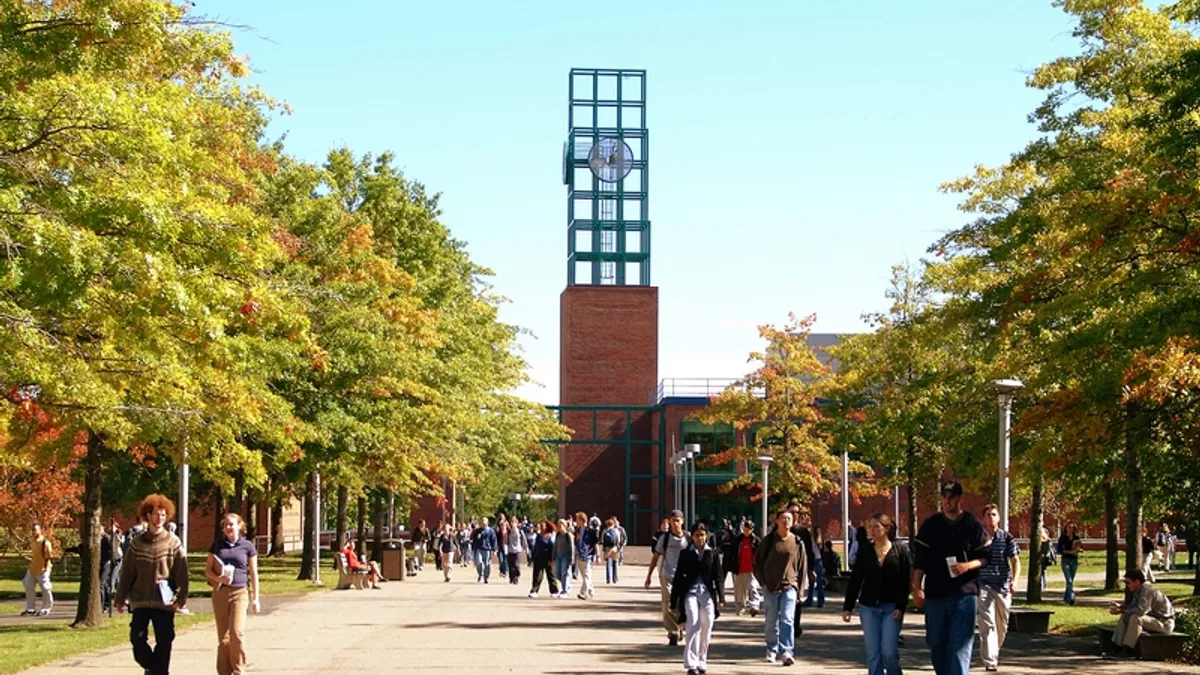Dive Brief:
- Binghamton University's president went public Thursday with a pitch to more closely knit together the 18,000-student research institution with the 4,700-student Broome Community College, its two-year sibling within the State University of New York system.
- President Harvey Stenger wrote that "an integration of our two campuses" would make it easier for students to transfer from nearby Broome Community College to Binghamton University, make operations more efficient at each institution, allow scale to cut administrative costs and boost student numbers at the two-year institution, where enrollment has been flagging.
- The two institutions have asked SUNY's chancellor, Deborah Stanley, to advance a proposal to the system's board of trustees, according to Stenger.
Dive Insight:
Any talk that approaches the idea of merging campuses or administrations within the 64-institution SUNY system is sure to draw attention because of its history. In 2011, then-Chancellor Nancy Zimpher sought to share presidents between three sets of campuses: Potsdam and Canton, Delhi and Cobleskill, Morrisville and what was then SUNY Institute of Technology in Utica. The arrangements drew backlash, and today the campuses each have their own presidents again.
At the same time, public systems in surrounding states, from Pennsylvania to the south to Vermont in the east, are carrying out institutional mergers in the face of challenging financial and demographic trends.
Talk of integrating Binghamton University and Broome Community College comes as the two-year college's president, Kevin Drumm, plans to retire next summer. Community colleges across the system have also been struggling of late, Stenger wrote.
Since 2011, SUNY Broome's enrollment fell by 37%. That's a sharp contrast to Binghamton University's enrollment rising by 22% in the same period.
Binghamton University is also seeing its transfer enrollment pipeline shrinking, especially from its home Broome County.
"Given these challenges, I believe that an integration of University and community college functions would have positive impacts on both institutions as well as the community," Stenger wrote. "And most of all, it would improve educational outcomes for transfer students, especially those coming from first-generation and underrepresented minority backgrounds."
Stenger pointed to an existing effort, the Binghamton Advantage Program, as proof that coordination between the two institutions can work. The program allows some SUNY Broome first-year students to live at Binghamton University. If they have a 3.0 GPA, they are guaranteed the ability to transfer to the university.
At the same time, a close partnership between the two institutions would uphold the community college's open-admissions mission, Stenger argued.
Each institution would continue to operate a separate campus, a Binghamton University spokesperson said in an email. Beyond that, details on exactly what such an integration might look like were scarce Friday.
Spokespeople for the two campuses and the SUNY system repeatedly stressed discussions are at an early stage.
"We are aware of the proposition and are discussing it with Binghamton," a SUNY spokesperson said in an email.
More details may be available after the holiday season, the community college said in a statement.
Any expanded relationship between the institutions would aim to benefit the regional workforce and employer partnerships, it said. It referenced finding efficiencies between administrative teams.
But it also said an enhanced partnership would aim to keep all jobs intact.
"We see an opportunity to better serve our students through value-added integration in areas where it provides the most benefit to our community," SUNY Broome's statement said.













